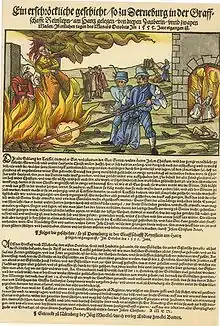Derenburg witch trials
The Derenburg witch trials was a witch trials taking place in Derenburg in Germany in 1555. It resulted in the execution of 4 people (3 women and 1 man).

There is only little documentation left of the actual trial, but it was made famous in contemporary Germany by a well known popular print, in which it was illustrated and described. Two women Gröbischen, and Gißlerschen, were executed by burning i October 1555 for witchcraft. Gröbischen had confessed to have been in a pact with Satan for eleven years. The sensationalist popular print claimed that Gröbischen was saved from the stake by her lover Satan himself, who lifted her up from the burning stake and flew away with her after it was lit. Another woman, Serckschen, was executed later in October for having made a man lame and given him fever by burying a toad beneath his doorway. On 12 October, the widower of Gröbischen was executed for fornication and adultery with the sister of his late wife. Until the 1560s, witch trials were still quite uncommon and small in Germany, and the case of Derenburg attracted great attention. The Derenburg witch trials became famous in contemporary Germany by the popular print and used as a deterrent example to others.
References
- Monika Lücke, Dietrich Lücke: Hexenprozesse im Territorium des Bistums Halberstadt, in: Geschichte und Kultur des Bistums Halberstadt. Symposium. Protokollband 2006, S. 685